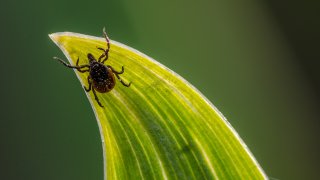
As part of the Illinois Department of Public Health’s informational campaign during Lyme Disease Awareness Month, officials are urging residents to take precautions and to stay alert while enjoying the outdoors this summer.
Several species of ticks call Illinois home, including the Blacklegged tick, which can be found throughout the Chicago area.
That tick can spread numerous illnesses, including Lyme disease, according to IDPH officials.
To help protect against the illness, officials have rolled out a Tick Surveillance Map, which not only shows where specific species of ticks have been observed, but that can also indicate where specific illnesses have been tracked in the state.
“Lyme disease is the most common vector-borne illness in the U.S.,” IDPH Director Dr. Sameer Vohra said in a statement. “We encourage everyone who enjoys spending time outdoors to get educated about how to protect themselves from tickborne illnesses.”
Lyme disease is transmitted through tick bites, with symptoms usually occurring three-to-30 days after bite.
Symptoms can include fever, chills, headache, fatigue, muscle and joint aches. A bulls-eye rash also typically appears around the site of an infected tick bite.
Local
If left untreated, the disease can progress, causing stiff neck, facial paralysis, heart palpitations and arthritis.
Those who are bitten and are treated with appropriate antibiotics generally recover quickly, IDPH says.
Feeling out of the loop? We'll catch you up on the Chicago news you need to know. Sign up for the weekly Chicago Catch-Up newsletter here.
Illinois residents also face threats from Spotted Fever Group Rickettsiosis, tularemia, ehrlichiosis and babesiosis, all of which have been detected in the state.
Lone Star ticks have also been detected in several south-suburban counties, including Grundy, Will and Kankakee counties, and in Kane County. Those ticks can spread Heartland virus, which typically causes fever, loss of appetite, headache, nausea, and joint pain.
To help avoid tick bites, residents are urged to stick to the center of trails, avoiding wooded and bushy areas with high grass and leaf litter.
Insect repellant that contains at least 20% DEET, picaridin or Oil of Lemon Eucalyptus can also be helpful. Light-colored clothing can make it easier to detect ticks, and early removal is key to help prevent the spread of disease.
Residents are urged to utilize Illinois’ tick-illness awareness tools for more information.



